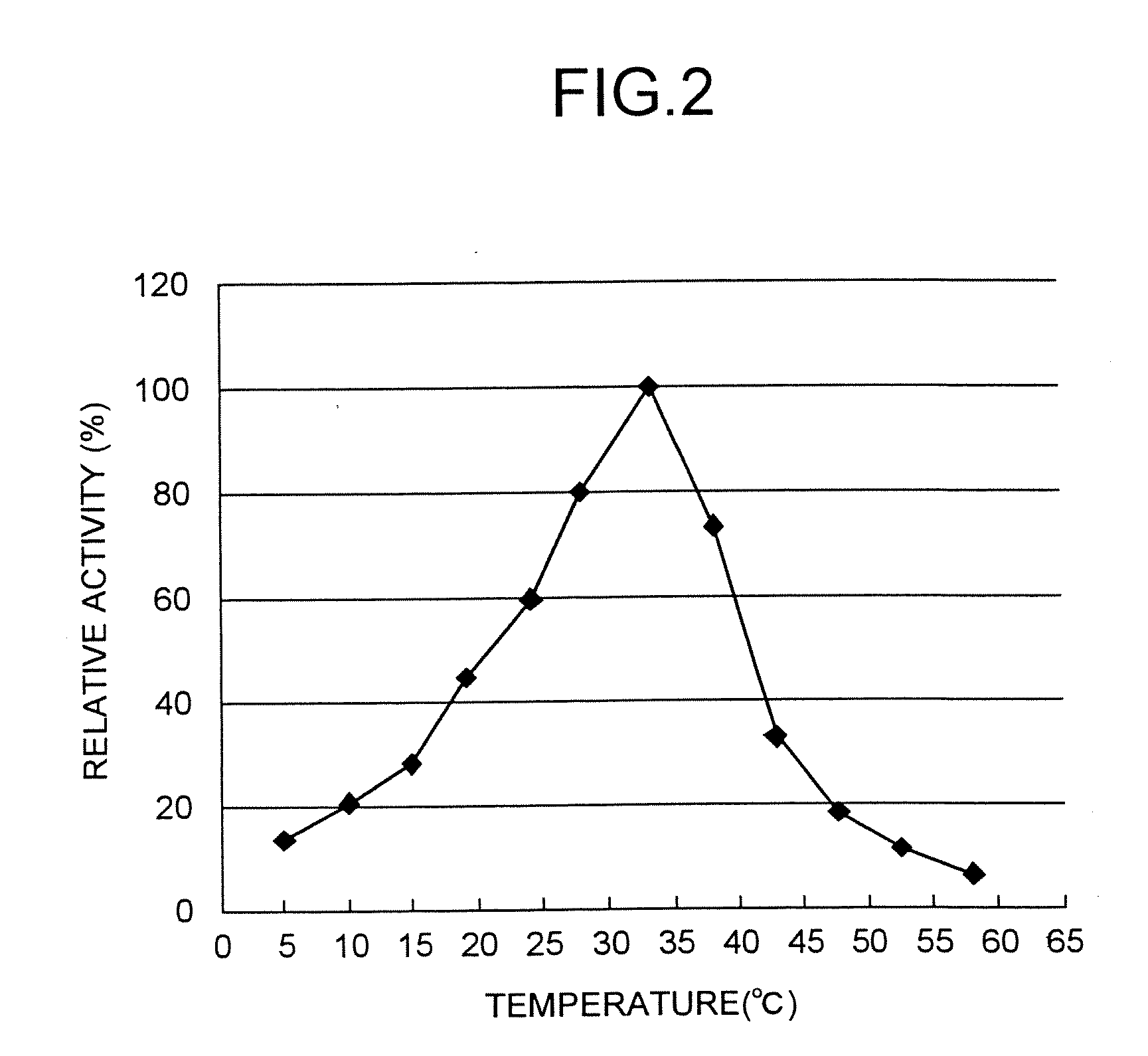Method for producing tripeptides and/or peptides longer than tripeptides
a technology of tripeptides and peptides, which is applied in the direction of peptide/protein ingredients, peptide sources, transferases, etc., can solve the problems of limited peptides that can be produced, low peptide production yield, and extreme slow rate of peptide production, and achieves low cost, high yield and easy production.
- Summary
- Abstract
- Description
- Claims
- Application Information
AI Technical Summary
Benefits of technology
Problems solved by technology
Method used
Image
Examples
example 1
Cultivation of Microbe (Empedobacter brevis FERM BP-8113)
[0130]A 50 mL medium (pH 6.2) containing 5 grams (g) glucose, 5 g ammonium sulfate, 1 g monopotassium phosphate, 3 g dipotassium phosphate, 0.5 g magnesium sulfate, 10 g yeast extract and 10 g peptone in 1 liter (L) was transferred to a 500 mL Sakaguchi flask and sterilized at 115° C. for 15 minutes. This medium was then inoculated with one loopful cells of Empedobacter brevis strain FERM BP-8113 (Depositary institution: the independent administrative corporation, National Institute of Advanced Industrial Science and Technology, International Patent Organism Depositary, Address of depositary institution: Chuo Dai-6, 1-1 Higashi 1-Chome, Tsukuba-shi, Ibaraki-ken, Japan, International deposit transfer date: Jul. 8, 2002) that had been cultured at 30° C. for 16 hours in the same medium, followed by shake culturing at 30° C. for 16 hours and 120 strokes / min.
example 2
Production of Peptide Using Microbial Cells
[0131]Microbial cells were collected by centrifuging (10,000 rounds per minute (rpm), 15 minutes) the culture broth obtained in Example 1 followed by suspending to a concentration of 100 g / L in 100 mM borate buffer (pH 9.0) containing 10 mM EDTA. After respectively adding 1 mL of this suspension to 1 mL of 100 mM borate buffer (pH 9.0) containing 10 mM EDTA, 200 mM of the following carboxy components and 400 mM of the following amino acids to bring to a final volume of 2 mL, the reaction was carried out at 18° C. for 2 hours. The peptides that were formed as a result of this reaction are shown in Table 1.
TABLE 1CarboxyAmineFormedCarboxyAmineFormedcomponentcomponentpeptide(mM)componentcomponentpeptide(mM)L-Ala-OMeL-LeuL-Ala-L-Leu38.2Gly-OMeL-HisL-Gly-L-His22.1L-MetL-Ala-L-Met68.3L-Ser-OMeL-SerL-Ser-L-Ser29.0L-PheL-Ala-L-Phe62.4L-Val-OMeL-MetL-Val-L-Met10.5L-SerL-Ala-L-Ser51.3L-Met-OMeL-PheL-Met-L-Phe28.5L-HisL-Ala-L-His52.1L-Thr-OMeL-LeuL-Th...
example 3
Purification of Enzyme
[0132]The procedure after centrifugal separation was carried out either on ice or at 4° C. Empedobacter brevis strain FERM BP-8113 (Depositary institution: the independent administrative corporation, National Institute of Advanced Industrial Science and Technology, International Patent Organism Depositary, Address of depositary institution: Chuo Dai-6, 1-1 Higashi 1-Chome, Tsukuba-shi, Ibaraki-ken, Japan, International deposit transfer date: Jul. 8, 2002) was cultivated in the same manner in as Example 1, and the microbial cells were collected by centrifugal separation (10,000 rpm, 15 minutes). After washing 16 g of microbial cells with 50 mM Tris-HCl buffer (pH 8.0), they were suspended in 40 milliliters (ml or mL) of the same buffer and subjected to ultrasonic disrupting treatment for 45 minutes at 195 watts. This sonicate was then centrifuged (10,000 rpm, 30 minutes) to remove the cell debris and obtain an ultrasonically disrupted liquid supernatant. This ul...
PUM
| Property | Measurement | Unit |
|---|---|---|
| temperature | aaaaa | aaaaa |
| temperature | aaaaa | aaaaa |
| temperature | aaaaa | aaaaa |
Abstract
Description
Claims
Application Information
 Login to View More
Login to View More - R&D
- Intellectual Property
- Life Sciences
- Materials
- Tech Scout
- Unparalleled Data Quality
- Higher Quality Content
- 60% Fewer Hallucinations
Browse by: Latest US Patents, China's latest patents, Technical Efficacy Thesaurus, Application Domain, Technology Topic, Popular Technical Reports.
© 2025 PatSnap. All rights reserved.Legal|Privacy policy|Modern Slavery Act Transparency Statement|Sitemap|About US| Contact US: help@patsnap.com



